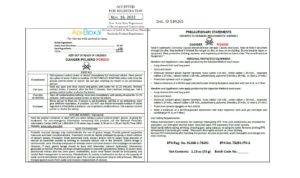Mite Check Protocol
Your bees have varroa mites! they are the primary threat to honey bees, it is your responsibility to check how many your bees have, to assess colony health. It is easy and simple to do, but very important even if you do not treat.
It is recommended to check at least 3 times a year, Spring/Summer/Fall, to determine if your bees are at risk. It is also important to know mites levels to determine if treatment is needed. If treating, do mite checks before and after treatment to determine efficacy.
—————————————————————————————————
Powdered Sugar Roll for mite counts
https://pollinators.msu.edu/resources/beekeepers/varroa-mite-monitoring1/
—————————————————————————————————–
Use of Oxalic Acid on Honey Bees (click here)
Extended-release oxalic acid for varroa management;
Feb. 2023
- NY-2EE (PDF)
2EE Recommendation for the Control of Varroa Mites – Use of a Mixture of Oxalic Acid and Glycerin Absorbed onto Cellulose Pads
Api-Bioxal (EPA Reg. No. 91266-1-73291)
Active Ingredient: Oxalic Acid Dihydrate
Application Rate: 50% Api-Bioxal; 50% Glycerin
November 28, 2022
Doc id: 584381
Oxalic Acid and Glycerin absorbed into cellulose pads (25g Api-Bioxal per pad). (Two 3½” x 8” pads per full sized colony).
Type of FIFRA 2(ee) Recommendation: Method of Application
Application Method: Using appropriate PPE and handling the pads with stainless-steel tongs. Place 2 pads centered on top of frames between the brood chambers. Remove after 60 days. Treatment may be repeated once per season.
Varroa Monitoring: Pre and post-treatment mite sampling. Treatment applied when threshold of 1-2% infestation (3-6 mites per 300 bees)
Directions for Use:
It is a violation of federal law to use this product in a manner inconsistent with its labeling.
This recommendation must be in the possession of the user at the time of pesticide application. Follow all applicable directions, precautions and restrictions on the product label.
To prepare mixture for use on colonies in double deep boxes:
- Dissolve 1 part Api-Bioxal in 1 part glycerin. For example, dissolve 350 g Api-Bioxal in 350 g glycerin to treat seven full-size colonies. (Each 100 g mixture of Api-Bioxal with glycerin can be used to treat one full-size )
- Over low/medium heat, while closely monitoring temperature, not to exceed 160 degrees, stir frequently until dissolved and mixture becomes translucent. Do not overheat the mixture. If the mixture becomes overheated, dispose as per the Pesticide Disposal directions on the product label and prepare a new mixture.
- Place the appropriate number of 3½” x 8” pads on edge in the plastic container. Each pad will receive 50 g of the Api-Bioxal/glycerin mixture. For example, use 14 pads after preparing 700 g of mixture.
- Pour approximately half of the mixture over the pads
- Using the tongs turn the pads onto the opposite edge, pour remaining mixture over the pads
- All liquid should be absorbed into the pads
- The treated pads can be stored in a cool dark place in an appropriately labeled sealed container for up to 2 months
2) NYS Stamped Label Api-Bioxal 11-18-22 (PDF)
3) Randy Oliver’s site:


